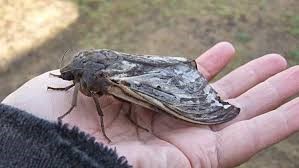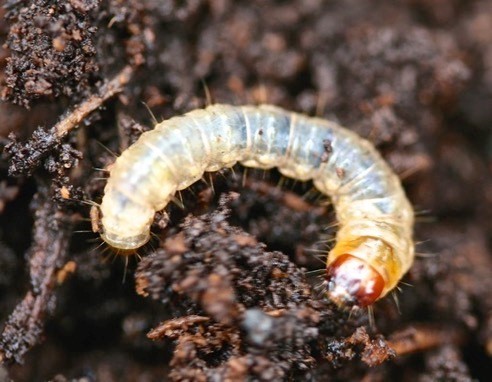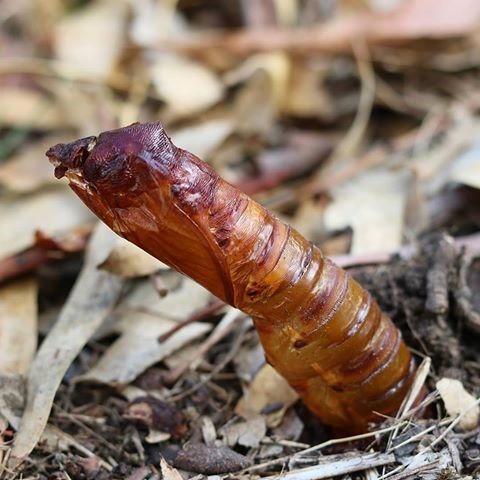One of the problems writing about Nature is that its timetable and that of the mere human Newsletter seems never to be synchronised. Last year a remarkable incident occurred, but it happened four weeks before my next article and therefore the main protagonist would have slipped away from Sanctuary Lakes, thereby cheating the readers of seeing it at that time. The protagonist was the Rain Moth, with a wing span of 16cm and a body length of 12cm, similar size in flight, to a sparrow. Besides its size, it easily distinguished by fawn coloured wings with two bright silver flash markings across each forewing. The Rain Moth is not only one of Australia’s largest Moths, but also has one of the strangest life cycles.

Rain Moth Trictena atripalpis
Last year’s incident happened on the way to the recreation centre for my early morning swim. Rain was just clearing and the sun hadn’t risen. The only light came out from the rec club’s big windows. Suddenly, resembling small bats or birds, four or five moths attracted by the rec club’s bright lights flew directly into them and hit the glass, falling unconscious to the floor. Examining them I realised I was meeting for the first time, a new Sanctuary Lakes neighbour, the extraordinary Rain Moth.
The Rain Moth’s name stems from the fact that adult moths often emerge after rain, during the autumn months of March and April. They are also known under other common names, Fishermen who use the caterpillar for bait nickname them ‘bardee’ or ‘bardi’ grub. The Aboriginal name is ‘Waikerie’ and one that reflects its short and final life cycle is the Swift Moth. Astonishingly the Rain Moths will only live for one day. For 24 hours their sole role in life is to mate and, if female, to then lay eggs. The moths cannot feed or drink because they don’t have the appropriate mouth parts to do so.
The female Rain Moth has the highest recorded egg laying capacity among non-social insects. One female was reported to lay 29,100 eggs, and when dissected 15,000 fully developed eggs were found in her ovaries. That means she had the potential to lay over 44,000 eggs. A female Rain Moth lays her eggs singly while flying, ‘bombing’ them in the general direction of the roots of gum trees allowing the rain to wash the eggs into crevices in the ground, along with dormant seeds that will germinate, so that when the eggs hatch the young caterpillar larvae can easily find fresh soft roots on which to feed.
The more eggs she lays during her short life the more chance there is that some hatching larvae will survive to find food and start a new generation

The Rain Moth Caterpillar: The Bardi Grub
Larvae are large grubs that can live in the ground for many years, feeding on gum tree roots, particularly the Acacias and Red Gums. The newly hatched grubs will burrow further into the ground where they continue feeding on tree roots. As they grow larger, the burrow in which they live will also become progressively larger, up to several centimetres in diameter. Other creatures, such as Trap-door and Wolf Spiders also make similarly sized holes, but Bardi Grub holes can be distinguished from these as they are lined with a substance somewhat resembling felt After several years the caterpillar will pupate under the ground in their tunnels and the mobile pupae wriggle towards the surface waiting for rain. After the adult Moth’s emergence, their pupal cases are left protruding from the ground, sometimes mistaken by some people for cicada skins. Evidence of their recent emergence from the ground is given away by the presence of these discarded skins at the entrance to their now empty holes after rain.

Discarded empty Rain Moth’s pupae shell
‘Rain moth’ is a great name for this moth because the adults only emerge from their pupal tunnels in early autumn after heavy rain or when rain is imminent. The moths are easy to find as they are attracted to our man-made lights at night. There are often one or two individuals who ‘jump the gun’ and when Farmers in particular see these early moths they know that rain is on the way.
The Rain Moths are a vital part of our local web of life, where for every creature there is another creature which will try to eat it. Rain Moth larvae are reasonably safe in their underground tunnels but emerging moths are vulnerable to attack. There main enemies are all flying creatures of the night, insectivorous Bats, Tawny Frogmouths and particularly in Sanctuary Lakes, Owls. Aborigines also enjoyed a cook up of Rain Moths. They claimed they tasted like a very nourishing mix of butter and sawdust.
March and April is the time to view the Sanctuary Lake’s Rain Moth. Since I met my Rain Moth last April, I have discussed it with other Sanctuary Lakes ‘twitchers’ who have also seen them around our neighbourhood and always after rain and if its dark, close to bright lights. If you have the fortune to see them, you will be surprised by the fluttering flight and amazed by their size.